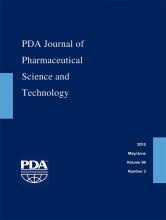Article CommentaryCommentary
Risk-based Strategy to Determine Testing Requirement for the Removal of Residual Process Reagents as Process-related Impurities in Bioprocesses
Jinshu Qiu, Kim Li, Karen Miller and Anil Raghani
PDA Journal of Pharmaceutical Science and Technology May 2015, 69 (3) 334-345; DOI: https://doi.org/10.5731/pdajpst.2015.01056
Jinshu Qiu
1Product Development, Amgen Inc., Thousand Oaks, CA USA; and
Kim Li
2Environment, Health, Safety and Sustainability, Amgen Inc., Thousand Oaks, CA USA
Karen Miller
1Product Development, Amgen Inc., Thousand Oaks, CA USA; and
Anil Raghani
1Product Development, Amgen Inc., Thousand Oaks, CA USA; and

References:
- 1.↵ICH Harmonized Tripartite Guideline. Specifications: Test Procedures and Acceptance Criteria for Biotechological/Biological Products, Q6B, ICH Steering Committee, 10 March 1999.
- 2.↵ICH Harmonized Tripartite Guideline. Quality Risk Management, Q9, Current Step 4 version, dated 9 November 2005.
- 3.↵
- Cogdill R. P.,
- Drennen J. K.
- 4.↵
- 5.↵
- outledge S. J.,
- Hewitt C. J.,
- Bora N.,
- Bill R. M.
- 6.↵
- Nema S.,
- Brendel R. J.
- 7.↵
- Powell M. F.,
- Nguyen T.,
- Baloian L.
- 8.↵
- Rowe R.,
- Sheskey P. J.,
- Cook W. G.,
- Fenton M. E.
- 9.↵
- Kasper D.,
- Braunwald E.,
- Hauser S.,
- Longo D.,
- Jameson L.,
- Fauci A.
- Howard L.
- 10.↵ICH Consensus Guideline. Guideline for elemental impurities, Q3D, Current Step 4 version dated 16 December 2014.
- 11.↵U.S. Food and Drug Administration, Center for Drug Evaluation and Research (FDA-CDER). Inactive Ingredient Search for Approved Drug Products, 2014.
- 12.↵Food and Drugs: Substances Generally Recognized as Safe. Code of Federal Regulations, Title 21, Part 182, Volume 3, Revised as of April 1, 2013.
- 13.↵ICH Harmonized Tripartite Guideline. Impurities: Guideline for Residual Solvents, Q3C (R5), 2011.
- 14.↵ICH Consensus Guideline. Assessment and Control of DNA Reactive (Mutagenic) Impurities in Pharmaceuticals to Limit Potential Carcinogenic Risk, M7. Current Step 4 version dated 23 June 2014.
- 15.↵ICH Harmonised Tripartite Guideline. Nonclinical Evaluation for Anticancer Pharmaceuticals, S9, Current Step 4 version dated 29 October 2009.
- 16.↵
- Zhao X.,
- Lin H.,
- Qiu J.
- 17.↵
- 18.↵
- 19.↵
- 20.↵FDA. Guidance for Industry: Process Validation: General Principles and Practices, 2013.
- 21.↵FDA, Center for Biologics Evaluation and Research. Points To Consider in the Manufacture and Testing of Monoclonal Antibody Products for Human Use. February 28, 1997.
- 22.↵The European Agency for Evaluation of Medicinal Products. Note for guidance on virus validation studies: the design, contribution, and interpretation of studies validating the inactivation and removal of viruses, cpmp/bwp/268/95, February 11, 1996.
In This Issue
PDA Journal of Pharmaceutical Science and Technology
Vol. 69, Issue 3
May/June 2015
Risk-based Strategy to Determine Testing Requirement for the Removal of Residual Process Reagents as Process-related Impurities in Bioprocesses
Jinshu Qiu, Kim Li, Karen Miller, Anil Raghani
PDA Journal of Pharmaceutical Science and Technology May 2015, 69 (3) 334-345; DOI: 10.5731/pdajpst.2015.01056
Risk-based Strategy to Determine Testing Requirement for the Removal of Residual Process Reagents as Process-related Impurities in Bioprocesses
Jinshu Qiu, Kim Li, Karen Miller, Anil Raghani
PDA Journal of Pharmaceutical Science and Technology May 2015, 69 (3) 334-345; DOI: 10.5731/pdajpst.2015.01056
Jump to section
Related Articles
- No related articles found.
Cited By...
- No citing articles found.





